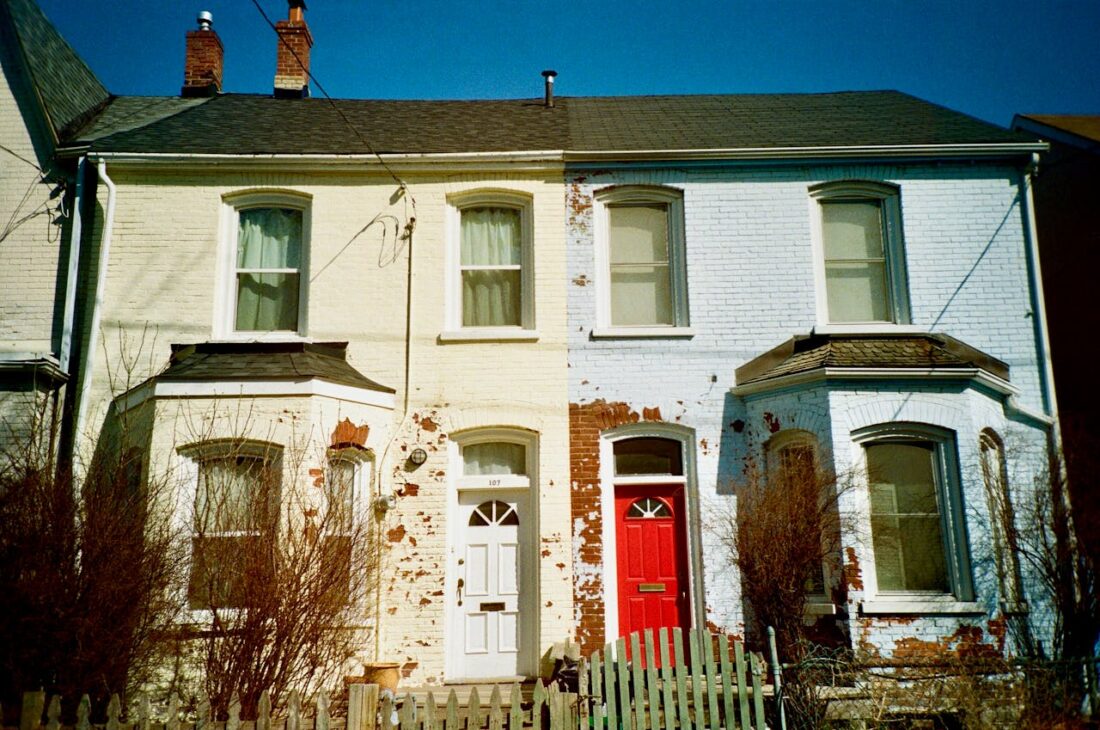
Image Alt Text: White and Gray Concrete House
Have you seen homes that look like one unit but have two front doors? That’s a duplex. They are prevalent in neighborhoods, maybe even yours, but how much do you really know about duplexes?
With today’s housing challenges, these properties are getting more attention in the minds of buyers and investors. Why? Maybe it’s the shared-cost potential or a house-like feel without the full price.
Regardless, this guide will cover all you need to know about duplexes, such as their definition, why buyers and renters want them, key tips for finding the perfect one for you, and more.
What Is a Duplex and Why Are They Popular in Today’s Market?
If you’re considering an investment property, understanding what is a duplex can help you make an informed decision. A duplex is fundamentally a single building with two separate homes inside it.
Each home will have its own entrance, kitchen, bathroom, etc., essentially everything you need. Sometimes they are side by side, like mirror images; other times, one home is stacked on top of the other one. There may also be a shared wall, and there may be shared outdoor space, such as a common backyard or driveway, as well.
How is this definition of “duplex” different from an apartment or a townhouse? With a duplex, the only real difference is the ownership. For example, a duplex usually has one owner who might live in one home and rent out the other home. This is what can make duplexes appealing to people who want to offset the costs of a mortgage or take a stab at being a real estate investor.
Of course, terms can also vary based on location. Take New York, for instance: a “duplex” apartment is a two-story apartment, not two separate apartments, so it makes sense for you to find out what your city means when they’re talking about a duplex.
Key Benefits of Living in a Duplex for Renters and Homebuyers
Whether you are a renter or a prospective buyer, duplexes consist of two units in one building that offer benefits different from traditional single-family homes and larger apartment buildings in multifamily communities.
Let’s analyze the advantages from different perspectives.
For Renters: Space and Value
For many tenants, renting a duplex unit is an improvement over a conventional rental apartment. With a duplex rental, you typically get more actual floor area, sometimes the enjoyment of a small outdoor yard, resulting in a greater sense of ownership and a reduced feeling of temporariness.
Living in a duplex layout also provides more privacy than living in a multi-unit complex. While you’re sharing the wall with your neighbor, this setup feels less institutional and more neighborhood-oriented.
As for the cost, renting one side of the home often costs between renting an apartment and a full house, meaning it will be slightly higher than normal rent but comes with good value, space, and privacy.
For Buyers & Owner-Occupants: Smart Finances
The greatest benefit for buyers, primarily first-time buyers or potential investors, would be financial. If you live in one unit and rent out the other, the rental income would dramatically reduce your mortgage payment and other associated ownership costs.
In some areas, this could make a purchase more cost-effective than a single-family home, and could be a practical method of introducing yourself into the market. You gain equity, and it feels partly like you have someone helping you pay the bill.
When you own separate units, you are also able to maintain physical separation from your tenants, which is a preferential arrangement for most compared to residing in the same home. It is an effective way to begin accruing equity.
Note that operating a duplex with a tenant can be tricky since you have to manage all aspects, from tenant relations to property maintenance. This is why seasoned investors partner with property managers. This is because choosing the right property management company in Richmond helps ensure tenant satisfaction and long-term occupancy.
General Perks: Location and Efficiency
In addition to specific benefits for the renter or buyer, duplexes typically fit well within neighbourhoods, allowing access to mature trees, grocery stores, and local offerings. They represent an efficient use of land and fit two homes into one single-family housing plot, which may help to improve housing availability.
Yes, you share a wall and the proverbial ‘noise transfer’ is a consideration, and as an owner-occupier, they also take on a landlord role. However, the main benefits, such as location, the financial model for owners, and the homelike experience for renters, make duplexes a worthwhile consideration in many markets worth exploring.
How to Find the Perfect Duplex for Your Investment Portfolio
Image Alt Text: Aerial Photo of a House
Selecting a duplex is not the same as choosing a regular house. The process deserves a little planning and thought as you consider whether you want to live in the duplex, rent it out, or combine both. What works for one person may not work for the next.
1. Define Your Purpose First
Why are you getting this duplex? If you’re going to live in one of the units and rent the other, are you prepared for landlord responsibilities? If you’re just renting both sides, you’re no longer a “landlord” and can focus entirely on the investment return and tenant appeal.
Your objectives will drive everything: location needs and budget limits, what renovations you can reasonably deal with. Identifying this early will help you avoid wasted time and making the wrong choice.
2. Location & Neighborhood Vibe
Think about who could occupy the unit? Are you near desirable schools, transit, or conveniences that tenants desire? Look for the feel of the actual neighborhood – is it quiet and not busy, or does it feel like a family neighbourhood? Go for a walk.
You also need your owner-occupants to enjoy living there. It’s important that the rental is close to places they find valuable, whether work or school, and overall, feels safe. A good-looking duplex in a bad area will often lead to headaches down the road.
3. Inspect Condition & Layout Closely
It is easy to be caught up in charm. Are heating systems, water heaters, and electrical panels for each unit active? This is ideal and can save you arguments in the future. What is the soundproofing quality of the shared wall or floor? How clean is the interior for indoor air quality?
How do you feel inside each unit? Is there usable space outside, and is it clearly defined who does what for maintenance? Older duplexes may need significant upgrades. Be prepared for this to strain your budget upfront, since you may spend more on repairs on a per-unit basis than on a house. As much as possible, don’t skip an inspection.
4. Run the Financial Numbers Carefully
This is an extremely important consideration for investors: calculate the numbers carefully. It should include the purchase price, the loan interest, property taxes, insurance (both HO6 and liability), and you should not forget to set money aside for maintenance and vacancy rates.
Be realistic about your potential rental income for both units based on current local market rates vs. guessing at numbers based on what you hope will happen. Calculate your potential cash flow after you pay all expenses. If you’re planning on owner-occupying, know that any additional rent you can earn from the other unit supports reasonable mortgage payments.
Conclusion
Duplexes offer a unique way forward, whether you want a less rental-like experience, to help cover ownership costs, or to build an investment portfolio. Duplexes are not the solution for everyone, but they offer a combination of space, potential income, and connectedness to your neighborhood.
In the end, it’s about consideration of the responsibilities, such as management of the property or shared walls, against the tangible benefits as they relate to your specific goals. If the price and lifestyle work out, it can be an effective step to take.



